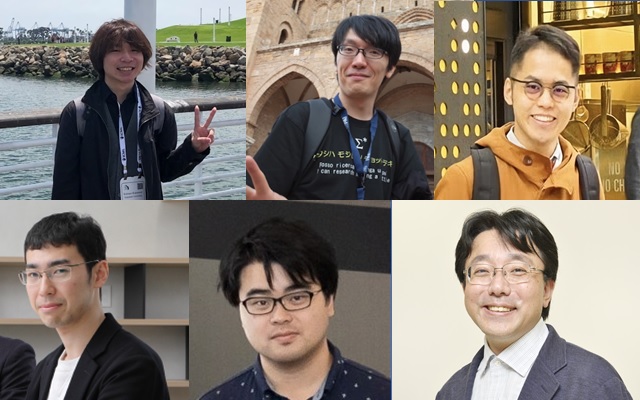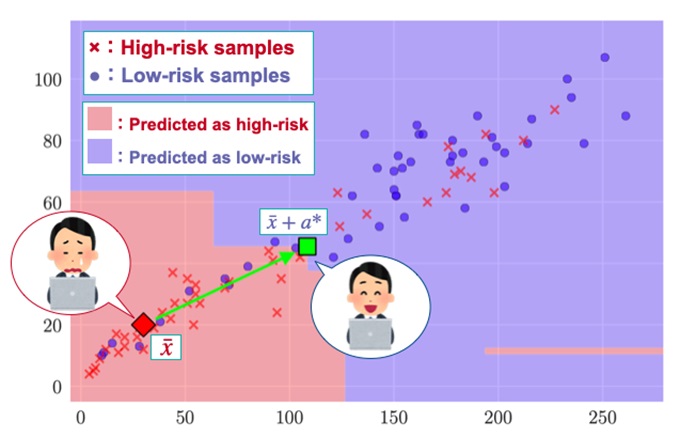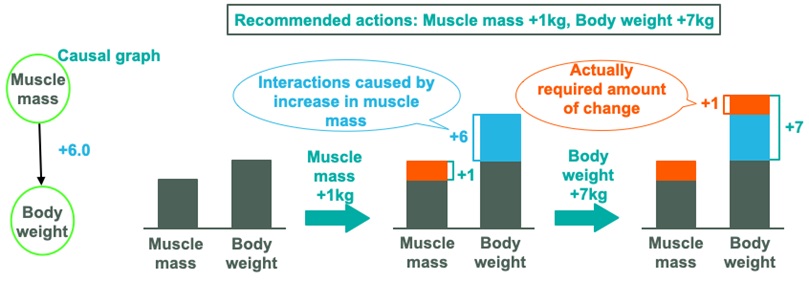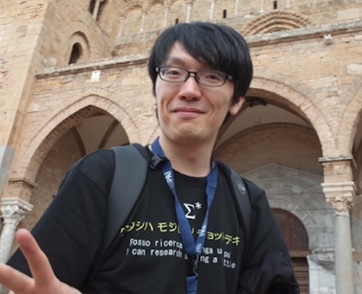Developing a new AI technology to recommend the optimal order of actions based on a counterfactual explanation
This research theme, which began with an internship, was accepted in AAAI-21!
February 4, 2021
JapaneseOne recent trend involves use of artificial intelligence (AI) to support decision-making in a variety of fields. Fujitsu Laboratories has been developing FUJITSU AI Technology Wide Learning (Wide Learning™![]() ), a machine learning tool designed to accelerate knowledge discovery, and we have devised technologies that suggest not only prediction results but also an action to obtain a desired outcome. This time, we developed a novel technology for recommending actions based on the concept of "counterfactual explanation", which has been attracting attention in the AI community: "would I be healthier if I lost a little weight?" For example, our technology can recommend an action "you would be healthier if you gained 1 kg of body weight by gaining 1 kg of muscle mass" to an unhealthy individual.
), a machine learning tool designed to accelerate knowledge discovery, and we have devised technologies that suggest not only prediction results but also an action to obtain a desired outcome. This time, we developed a novel technology for recommending actions based on the concept of "counterfactual explanation", which has been attracting attention in the AI community: "would I be healthier if I lost a little weight?" For example, our technology can recommend an action "you would be healthier if you gained 1 kg of body weight by gaining 1 kg of muscle mass" to an unhealthy individual.
This is a joint work with Professor Hiroki Arimura and first-year doctoral student Kentaro Kanamori in Hokkaido University, and was accepted in the AAAI-21, a major international conference in the AI field.
 From top left: Kentaro Kanamori (Hokkaido University), Takuya Takagi (Fujitsu Laboratories), and Ken Kobayashi (Fujitsu Laboratories and Tokyo Institute of Technology)
From top left: Kentaro Kanamori (Hokkaido University), Takuya Takagi (Fujitsu Laboratories), and Ken Kobayashi (Fujitsu Laboratories and Tokyo Institute of Technology)
From bottom left: Yuichi Ike (Fujitsu Laboratories), Kento Uemura (Fujitsu Laboratories), and Hiroki Arimua (Hokkaido University)
AAAI-21 overview
Detail of the technology
Counterfactual explanation (CE) is a post-hoc explanation for machine learning model that recommends an action as the amount of change in attribute values (a perturbation vector) necessary in order to change a prediction result of the model, as illustrated in Figure 1. Given a perturbation vector, the user can interpret it as an action necessary in order to obtain the desired outcome. For example, CE recommends a perturbation vector as an action that an unhealthy user need to become healthy.
 Figure 1. Computing the amount of change a*, in attributes that will alter the prediction result
Figure 1. Computing the amount of change a*, in attributes that will alter the prediction result
In practice, however, showing only a perturbation vector is often insufficient for users to execute the action. It is because when there are asymmetrical interactions, such as causal relationships, the cost of an action depends on the order in which attribute values are changed. Consequently, it is necessary to recommend the appropriate order in which to change attribute values as actions to the user. To resolve this issue, we developed ordered counterfactual explanation (OrdCE) as a new action extraction technique that can recommend the optimal order in which to change attribute values. The work was accepted in AAAI-21, as known as one of major international conferences.
First, OrdCE uses causal discovery techniques, which can find causal relationships between attributes on the training data. We introduce a new objective function that evaluates an action and its changing order based on the attribute interactions. The objective function takes into account how much past changes in attribute values affected other attribute values and evaluates overall actions by calculating how much change the user will need (see Figure 2). We can obtain the optimal action by solving a mixed-integer optimization problem that minimizes this objective function. Numerical experiments with real-world datasets verified that the technology generated appropriately ordered actions saving the cost of up to 200% compared to naive techniques that determined the order after first determining the actions.
 Figure 2. Determining optimal actions based on a consideration of interactions between attributes.
Figure 2. Determining optimal actions based on a consideration of interactions between attributes.
Comments from the Fujitsu Laboratories
Takuya Takagi, Ph.D.
Researcher, AI Core Technology Project
Artificial Intelligence Laboratory

"This technology can be used in a variety of classifiers, including linear models, tree ensemble models, and deep neural networks. In particular, it can be expected to generate richer action when used in combination with Wide Learning™, which discover rules from data.
In the future, we plan to conduct experiments with real-world datasets in a variety of business fields, including manufacturing processes and marketing research."
Collaboration between researchers from different fields
Fujitsu Laboratories promotes collaboration with researchers in different fields of expertise as well as partners in industry and academia. In developing this technology, we built a team whose members had expertise in different fields, including optimization and causal inference, and leveraged their respective strengths to create a more innovative technology.
Hiroki Arimura, Professor
Graduate School of Information Science and Technology
Hokkaido University

"I played a supervisory role on this team. While the young team members from Fujitsu Laboratories and Kentaro Kanamori (from my laboratory) had different research backgrounds, including in machine learning, optimization, discreate algorithms, and mathematics, they all shared a desire to create a new AI technology, which allowed us to form a productive and harmonious team. Although most of our discussions occurred online due to the numerous constraints imposed by the COVID-19 pandemic, the young members played a central role in every phase of the project, from creating research ideas to authoring the paper. This approach was the key to the project’s success."
Fujitsu Laboratories internship program
Kentaro Kanamori, one of the developers of this technology, participated in a FY2019 internship at Fujitsu Laboratories. During that internship, Kanamori discussed with Fujitsu Laboratories researchers that led to the idea of this technology.
Kentaro Kanamori
Graduate School of Information Science and Technology
Hokkaido University

"During my internship, I was able to conduct research freely with the aim of publishing a paper. I participated in many discussions with my mentor Dr. Takuya Takagi and other researchers, and the technology ended up being accepted in IJCAI-20. After the internship, I continued to participate in joint research via online tools, and finally the study was accepted in AAAI-21. Collaborating with researchers with various expertise, such as mathematical optimization and causal discovery, was a very valuable experience for me as an aspiring researcher. ”
The previous work developed during Kanamori’s internship was accepted in IJCAI-20, a major AI conference.
Fujitsu Laboratories will continue to work with university professors and students to develop innovative technologies that contribute to society together through industry-academia collaboration and internships.
Inquiries about this article
fj-widelearning@dl.jp.fujitsu.com
Please note that we would like to ask the people who reside in EEA (European Economic Area) to contact us at the following address.
Ask Fujitsu
Tel: +44-12-3579-7711
http://www.fujitsu.com/uk/contact/index.html![]()
Fujitsu, London Office
Address :22 Baker Street
London United Kingdom
W1U 3BW



